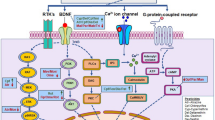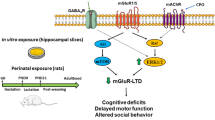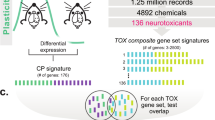Abstract
Chlorpyrifos (CPF), a commonly used organophosphorus insecticide, induces acetylcholinesterase inhibition and cholinergic toxicity. Subtoxic exposure to CPF has long-term adverse effects on synaptic function/development and behavioral performance. To gain insight into the possible mechanism(s) of these observations, this study aims to investigate gene expression changes in the forebrain of rats treated with subtoxic CPF doses using DNA microarrays. Statistical analysis revealed that CPF treatment resulted in differential expression of 277 genes. Gene ontology and pathway analyses revealed that these genes have important roles in nervous system development and functions including axon guidance, dorso-ventral axis formation, long-term potentiation, synaptic transmission, and insulin signaling. The results of biological associated network analysis showed that Gsk3b is highly connected in several of these networks suggesting its potential role in cellular response to CPF exposure/neurotoxicity. These findings might serve as the basis for future mechanistic analysis of the long-term adverse effects of subtoxic CPF exposure.



Similar content being viewed by others

References
Abdollahi M, Ranjbar A, Shadnia S, Nikfar S, Rezaie A (2004) Pesticides and oxidative stress: a review. Med Sci Monit 10:RA141–RA147
Abou-Donia MB (2003) Organophosphorus ester-induced chronic neurotoxicity. Arch Environ Health 58:484–497
Akaneya Y, Takahashi M, Hatanaka H (1995) Interleukin-1 beta enhances survival and interleukin-6 protects against MPP + neurotoxicity in cultures of fetal rat dopaminergic neurons. Exp Neurol 136:44–52
Arsenijevic Y, Weiss S (1998) Insulin-like growth factor–I is a differentiation factor for postmitotic CNS stem cell-derived neuronal precursors: distinct actions from those of brain-derived neurotrophic factor. J Neurosci 18:2118–2128
Bagchi D, Bagchi M, Hassoun EA, Stohs SJ (1995) In vitro and in vivo generation of reactive oxygen species, DNA damage and lactate dehydrogenase leakage by selected pesticides. Toxicology 104:129–140
Banerjee BD, Seth V, Ahmed RS (2001) Pesticide-induced oxidative stress: perspectives and trends. Rev Environ Health 16:1–40
Béréziat V, Kasus-Jacobi A, Perdereau D, Cariou B, Girard J, Burnol AF (2002) Inhibition of insulin receptor catalytic activity by the molecular adapter Grb14. J Biol Chem 277:4845–4852
Betancourt AM, Burgess SC, Carr RL (2006) Effect of developmental exposure to chlorpyrifos on the expression of neurotrophin growth factors and cell-specific markers in neonatal rat brain. Toxicol Sci 92:500–506
Bhat RV, Shanley J, Correll MP, Fieles WE, Keith RA, Scott CW, Lee CM (2000) Regulation and localization of tyrosine 216 phosphorylation of glycogen synthase kinase-3beta in cellular and animal models of neuronal degeneration. Proc Natl Acad Sci USA 97:11074–11079
Bhat RV, Leonov S, Luthman J, Scott CW, Lee CM (2002) Interactions between GSK3beta and caspase signalling pathways during NGF deprivation induced cell death. J Alzheimers Dis 4:291–301
Brunet A, Datta SR, Greenberg ME (2001) Transcription-dependent and -independent control of neuronal survival by the PI3K-Akt signaling pathway. Curr Opin Neurobiol 11:297–305
Bushnell PJ, Moser VC, Samsam TE (2001) Comparing cognitive and screening tests for neurotoxicity. Effects of acute chlorpyrifos on visual signal detection and a neurobehavioral test battery in rats. Neurotoxicol Teratol 23:33–44
Canadas F, Cardona D, Davila E, Sanchez-Santed F (2005) Long-term neurotoxicity of chlorpyrifos: spatial learning impairment on repeated acquisition in a water maze. Toxicol Sci 85:944–951
Chambers JE, Chambers HW (1989) Oxidative desulfuration of chlorpyrifos, chlorpyrifos-methyl, and leptophos by rat brain and liver. J Biochem Toxicol 4:201–203
Chin PC, Majdzadeh N, D’Mello SR (2005) Inhibition of GSK3beta is a common event in neuroprotection by different survival factors. Brain Res Mol Brain Res 137:193–201
Choi DK, Ito T, Tsukahara F, Hirai M, Sakaki Y (1999) Developmentally-regulated expression of mNapor encoding an apoptosis-induced ELAV-type RNA binding protein. Gene 237:135–142
Cipok M, Aga-Mizrachi S, Bak A, Feurstein T, Steinhart R, Brodie C, Sampson SR (2006) Protein kinase Calpha regulates insulin receptor signaling in skeletal muscle. Biochem Biophys Res Commun 345:817–824
Cohn J, MacPhail RC (1997) Chlorpyrifos produces selective learning deficits in rats working under a schedule of repeated acquisition and performance. J Pharmacol Exp Ther 283:312–320
Dam K, Seidler FJ, Slotkin TA (2003) Transcriptional biomarkers distinguish between vulnerable periods for developmental neurotoxicity of chlorpyrifos: implications for toxicogenomics. Brain Res Bull 59:261–265
Dettbarn WF, Milatovic D, Gupta RC (2006) Oxidative stress in anticholinesterase-induced excitotoxicity. In: Gupta RC (ed) Toxicology of organophosphate and carbamate compounds. Elsevier, Amsterdam
Doble BW, Woodgett JR (2003) GSK-3: tricks of the trade for a multi-tasking kinase. J Cell Sci 116:1175–1186
Dow Agro Sciences (2003) Toxicological properties of chlorpyrifos. Dow Chemical Company, Indianapolis, IN
Duarte AI, Santos MS, Oliveira CR, Rego AC (2005) Insulin neuroprotection against oxidative stress in cortical neurons-involvement of uric acid and glutathione antioxidant defenses. Free Radic Biol Med 39:876–889
Echobichon DJ (1982) Organophosphorus ester insecticides. In: Ecobichon DJ, Joy RM (eds) Pesticides and neurological disease. CRC Press, Boca Raton, FL
Eto M (1979) Organophosphorus pesticides: organic and biological chemistry. CRC Press, Boca Raton, FL
Forsyth CS, Chambers JE (1989) Activation and degradation of the phosphorothionate insecticides parathion and EPN by rat brain. Biochem Pharmacol 38:1597–1603
Frame S, Cohen P (2001) GSK3 takes centre stage more than 20 years after its discovery. Biochem J 359:1–16
Geppert M, Ushkaryov YA, Hata Y, Davletov B, Petrenko AG, Sudhof TC (1992) Neurexins. Cold Spring Harb Symp Quant Biol 57:483–490
Gore AC (2002) Organochlorine pesticides directly regulate gonadotropin-releasing hormone gene expression and biosynthesis in the GT1–7 hypothalamic cell line. Mol Cell Endocrinol 192:157–170
Grimes CA, Jope RS (2001) The multifaceted roles of glycogen synthase kinase 3beta in cellular signaling. Prog Neurobiol 65:391–426
Gu S, Roderick HL, Camacho P, Jiang JX (2001) Characterization of an N-system amino acid transporter expressed in retina and its involvement in glutamine transport. J Biol Chem 276:24137–24144
Herron CE, Lester RA, Coan EJ, Collingridge GL (1986) Frequency-dependent involvement of NMDA receptors in the hippocampus: a novel synaptic mechanism. Nature 322:265–268
Ikeda S, Kishida S, Yamamoto H, Murai H, Koyama S, Kikuchi A (1998) Axin, a negative regulator of the Wnt signaling pathway, forms a complex with GSK-3beta and beta-catenin and promotes GSK-3beta-dependent phosphorylation of beta-catenin. EMBO J 17:1371–1384
Impey S, Mark M, Villacres EC, Poser S, Chavkin C, Storm DR (1996) Induction of CRE-mediated gene expression by stimuli that generate long-lasting LTP in area CA1 of the hippocampus. Neuron 16:973–982
Karanth S, Pope C (2000) Carboxylesterase and A-esterase activities during maturation and aging: relationship to the toxicity of chlorpyrifos and parathion in rats. Toxicol Sci 58:282–289
Kasus-Jacobi A, Perdereau D, Tartare-Deckert S, Van OE, Girard J, Burnol AF (1997) Evidence for a direct interaction between insulin receptor substrate–1 and Shc. J Biol Chem 272:17166–17170
Kasus-Jacobi A, Perdereau D, Auzan C, Clauser E, Van OE, Mauvais-Jarvis F, Girard J, Burnol AF (1998) Identification of the rat adapter Grb14 as an inhibitor of insulin actions. J Biol Chem 273:26026–26035
Kovacic P (2003) Mechanism of organophosphates (nerve gases and pesticides) and antidotes: electron transfer and oxidative stress. Curr Med Chem 10:2705–2709
Mense SM, Sengupta A, Lan C, Zhou M, Bentsman G, Volsky DJ, Whyatt RM, Perera FP, Zhang L (2006) The common insecticides cyfluthrin and chlorpyrifos alter the expression of a subset of genes with diverse functions in primary human astrocytes. Toxicol Sci 93:125–135
Milatovic D, Gupta RC, Aschner M (2006) Anticholinesterase toxicity and oxidative stress. Sci World J 6:295–310
Moosmang S, Haider N, Klugbauer N, Adelsberger H, Langwieser N, Muller J, Stiess M, Marais E, Schulla V, Lacinova L, Goebbels S, Nave KA, Storm DR, Hofmann F, Kleppisch T (2005) Role of hippocampal Cav1.2 Ca2 + channels in NMDA receptor–independent synaptic plasticity and spatial memory. J Neurosci 25:9883–9892
Morgan SL, Teyler TJ (2001) Electrical stimuli patterned after the theta-rhythm induce multiple forms of LTP. J Neurophysiol 86:1289–1296
Moroo I, Yamada T, Makino H, Tooyama I, McGeer PL, McGeer EG, Hirayama K (1994) Loss of insulin receptor immunoreactivity from the substantia nigra pars compacta neurons in Parkinson’s disease. Acta Neuropathol 87:343–348
Moser VC, Phillips PM, McDaniel KL, Marshall RS, Hunter DL, Padilla S (2005) Neurobehavioral effects of chronic dietary and repeated high-level spike exposure to chlorpyrifos in rats. Toxicol Sci 86:375–386
Murphy SD (1986) Toxic effects of pesticides. In: Klaassen CD, Amdur MO, Doull J (eds) The basic science of poisons, 3rd edn edn. MacMillan, New York
Nakagawa T, Goto K, Kondo H (1996) Cloning, expression, and localization of 230–kDa phosphatidylinositol 4-kinase. J Biol Chem 271:12088–12094
Nakagawa-Yagi Y, Choi DK, Ogane N, Shimada S, Seya M, Momoi T, Ito T, Sakaki Y (2001) Discovery of a novel compound: insight into mechanisms for acrylamide-induced axonopathy and colchicine-induced apoptotic neuronal cell death. Brain Res 909:8–19
Nelson MT, Quayle JM (1995) Physiological roles and properties of potassium channels in arterial smooth muscle. Am J Physiol 268:C799–C822
Nguyen PV, Woo NH (2003) Regulation of hippocampal synaptic plasticity by cyclic AMP-dependent protein kinases. Prog Neurobiol 71:401–437
Paschen W, Yatsiv I, Shoham S, Shohami E (2004) Brain trauma induces X-box protein 1 processing indicative of activation of the endoplasmic reticulum unfolded protein response. J Neurochem 88:983–992
Pope CN, Tanaka D Jr, Padilla S (1993) The role of neurotoxic esterase (NTE) in the prevention and potentiation of organophosphorus-induced delayed neurotoxicity (OPIDN). Chem Biol Interact 87:395–406
Ranta S, Zhang Y, Ross B, Takkunen E, Hirvasniemi A, de la CA, Gilliam TC, Lehesjoki AE (2000) Positional cloning and characterisation of the human DLGAP2 gene and its exclusion in progressive epilepsy with mental retardation. Eur J Hum Genet 8:381–384
Raymond CR, Redman SJ (2006) Spatial segregation of neuronal calcium signals encodes different forms of LTP in rat hippocampus. J Physiol 570:97–111
Rosenzweig T, Braiman L, Bak A, Alt A, Kuroki T, Sampson SR (2002) Differential effects of tumor necrosis factor-alpha on protein kinase C isoforms alpha and delta mediate inhibition of insulin receptor signaling. Diabetes 51:1921–1930
Samsam TE, Hunter DL, Bushnell PJ (2005) Effects of chronic dietary and repeated acute exposure to chlorpyrifos on learning and sustained attention in rats. Toxicol Sci 87:460–468
Savinainen A, Garcia EP, Dorow D, Marshall J, Liu YF (2001) Kainate receptor activation induces mixed lineage kinase-mediated cellular signaling cascades via post-synaptic density protein 95. J Biol Chem 276:11382–11386
Slotkin TA (2004) Cholinergic systems in brain development and disruption by neurotoxicants: nicotine, environmental tobacco smoke, organophosphates. Toxicol Appl Pharmacol 198:132–151
Takahashi R, Deveraux Q, Tamm I, Welsh K, ssa-Munt N, Salvesen GS, Reed JC (1998) A single BIR domain of XIAP sufficient for inhibiting caspases. J Biol Chem 273:7787–7790
Thiery JP, Brackenbury R, Rutishauser U, Edelman GM (1977) Adhesion among neural cells of the chick embryo. II. Purification and characterization of a cell adhesion molecule from neural retina. J Biol Chem 252:6841–6845
Ule J, Jensen KB, Ruggiu M, Mele A, Ule A, Darnell RB (2003) CLIP identifies Nova-regulated RNA networks in the brain. Science 302:1212–1215
Ushkaryov YA, Südhof TC (1993) Neurexin III alpha: extensive alternative splicing generates membrane–bound and soluble forms. Proc Natl Acad Sci USA 90:6410–6414
Ushkaryov YA, Petrenko AG, Geppert M, Sudhof TC (1992) Neurexins: synaptic cell surface proteins related to the alpha-latrotoxin receptor and laminin. Science 257:50–56
Villegas SN, Njaine B, Linden R, Carri NG (2006) Glial–derived neurotrophic factor (GDNF) prevents ethanol (EtOH) induced B92 glial cell death by both PI3 K/AKT and MEK/ERK signaling pathways. Brain Res Bull 71:116–126
Whitney KD, Seidler FJ, Slotkin TA (1995) Developmental neurotoxicity of chlorpyrifos: cellular mechanisms. Toxicol Appl Pharmacol 134:53–62
Zhang W, Liu H, Han K, Grabowski PJ (2002) Region-specific alternative splicing in the nervous system: implications for regulation by the RNA-binding protein NAPOR. RNA 8:671–685
Zhang WR, Li PM, Oswald MA, Goldstein BJ (1996) Modulation of insulin signal transduction by eutopic overexpression of the receptor-type protein-tyrosine phosphatase LAR. Mol Endocrinol 10:575–584
Acknowledgments
The authors would like the thank Major Diane Todd for the management of this research program, Dr. Nicolas DelRaso and Ms. Deirdre Mahle for coordinating and supervising of the animal study, and Drs. David Mattie and Peter Robinson for constructive discussion.
Author information
Authors and Affiliations
Corresponding author
Additional information
Dataset accession # GSE9751.
Electronic supplementary material
Below is the link to the electronic supplementary material.
204_2008_346_MOESM1_ESM.doc
Supplemental Table S1. The Affymetrix probe ID, gene name/description, and change direction of the entire list of 277 differential expressed genes (DOC 325 kb)
204_2008_346_MOESM2_ESM.doc
Supplemental Table S2. Complete lists of enriched gene ontology (GO) categories and pathways, number of genes in each of these GO categories/pathways and the statistical significance of enhancement generated using the gene lists of low-dose, high-dose and entire dose ranges as input data in DAVID analyses (DOC 279 kb)
204_2008_346_MOESM3_ESM.doc
Supplemental Table S3. The entire lists of pathways and the direction of gene expression changes involved in each of these pathways determined using GenMAPP (DOC 191 kb)
204_2008_346_MOESM4_ESM.doc
Supplemental Table S4. The entire list of genes and the direction of expression changes involved in the biological association networks of binding complexes, metabolism regulation, post-translational modification, small molecule interaction, transcription regulation, and transport regulation determined using PathwayArchitect (DOC 117 kb)
Rights and permissions
About this article
Cite this article
Stapleton, A.R., Chan, V.T. Subtoxic chlorpyrifos treatment resulted in differential expression of genes implicated in neurological functions and development. Arch Toxicol 83, 319–333 (2009). https://doi.org/10.1007/s00204-008-0346-2
Received:
Accepted:
Published:
Issue Date:
DOI: https://doi.org/10.1007/s00204-008-0346-2



